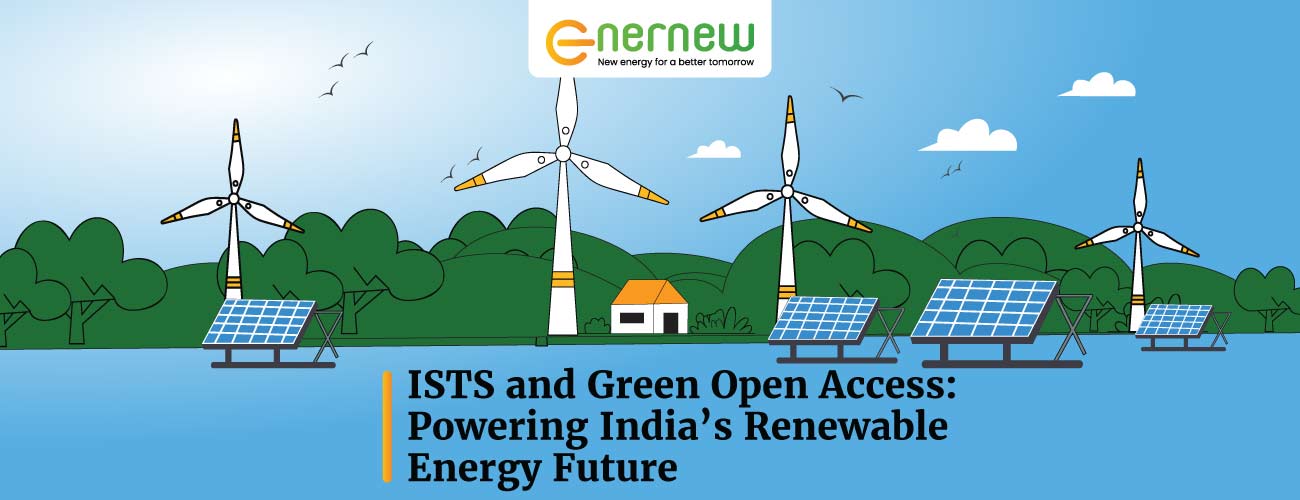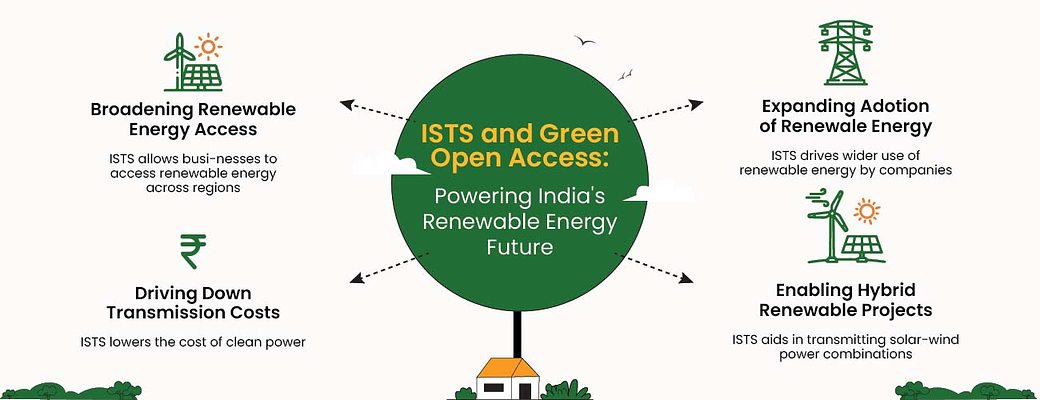ISTS and Green Open Access: Powering India’s Renewable Energy Future

As India continues to evolve as one of the largest renewable energy markets in the world, businesses all across the nation are increasingly turning towards Green Open Access (GOA) as a solution to lower energy costs and contribute to India’s ambition of increasing non-fossil fuel based energy capacity to 500 GW by the end of the decade (2030).
One of the prominent factors in driving the growth of the Green Open Access model is the Interstate Transmission System (ISTS), playing an essential role in allowing businesses to access renewable energy across the country.
What is Green Open Access (GOA)?
Green Open Access is a system that empowers businesses in Commercial and Industrial (C&I) sectors to procure renewable energy directly from the producer, allowing them to bypass the conventional utility channels. This model not only helps in reducing the energy costs but also supports the renewable energy goals by using power from clean energy sources.
However, to make the procurement model efficient, a dynamic transmission network plays a critical role. This is where ISTS comes into play!

What is ISTS?
The Interstate Transmission System (ISTS) consists of high-voltage transmission lines that facilitate power transfer between states across India. India’s energy grid features this main transmission element, which enables power generated in one state to reach other states to meet rising energy consumption needs.
The Interstate Transmission System provides uninterrupted power transmission of renewable energy from energy-abundant regions such as Rajasthan, Tamil Nadu, Karnataka, Gujarat,, and Maharashtra to businesses located in other parts of the country. Without the ISTS system, companies would be confined to local sources, which often result in high costs and few renewable options.
The Role of ISTS in Supporting Green Open Access
From 2022, the waivers on ISTS transmission charges and General Network access regulations have opened the ISTS market for Green Open Access. The Interstate Transmission System plays a vital role in enabling Green Open Access for businesses who are looking to make their energy consumption sustainable.
Expanding The Reach of Renewable Energy
One of the major benefits of ISTS is breaking down the geographical barriers. Earlier, businesses had to rely on the local grid and had limited access to sustainable energy. With ISTS, businesses have the opportunity to tap into the renewable-rich areas and procure energy to ensure a stable supply.
It ultimately lowers the heavy reliance on fossil fuels and allows businesses to achieve both cost savings and sustainability objectives. It is beneficial for the C&I sector as it will allow companies, both small and large, to reduce their carbon footprint by switching to renewable energy, irrespective of their location in the country.
Lowering the Transmission Costs
One of the biggest challenges to sourcing sustainable energy from outside of the local area is high transmission costs. With the waivers on ISTS charges, businesses can access renewable energy at lower rates. It makes Green Open Access cost-effective and empowers businesses to adopt the model.
Waivers will decrease by 25% annually from July 2025 to June 2028. After that, no waivers will apply to ISTS projects, except for those related to offshore wind energy and green hydrogen production, and 100% of ISTS charges will be imposed on projects commissioning after 1st July 2028. The waivers are valid for 25 years from the date of commissioning and for Battery Energy Storage Systems, it is limited to 12 years.
Supporting Hybrid Renewable Energy Projects
As the Government of India continuously supports hybrid energy projects that combine both wind and solar energy, ISTS play a critical role in making these projects successful. These hybrid setups offer a consistent energy supply from both wind and solar sources as per the weather conditions, making it a more reliable option.
It is particularly favourable for the industries with high energy demands that need a reliable power source to ensure continuous supply.

How Do Businesses Benefit From Sourcing Renewable Energy Via ISTS?
-
By signing up for the Interstate Transmission System, businesses can lower their energy costs by up to 20-50% annually.
-
With an expanding capacity of the ISTS network, it ensures a consistent energy supply to meet the increasing demands, and lowers the risk of power disruptions and shortages.
-
Companies adopting renewable energy solutions also enhance their brand image and reputation and attract customers who value eco-friendly practices.
Partnering with Enernew For Seamless Integration of Solar Energy Solutions
Enernew is a leading Solar energy company in India, with extensive experience in implementing 100 MWp+ Solar projects and has partnered up with more than 50 companies across industries to meet growing energy needs. With our 50 MW solar park in Bikaner, Rajasthan, we specialise in providing On-Site C&I Solar Projects, Off-Site Captive Open Access Solar Parks, modern renewable technologies, including wind, advanced wind-solar hybrids and Battery Energy Storage Systems, empowering businesses to harness the true potential of renewable energy.
Schedule a consultation with Enernew today and discover how we can help you transition to a sustainable and cost-effective energy solution.

